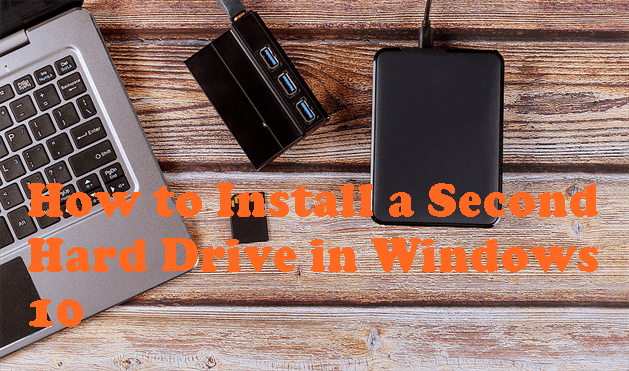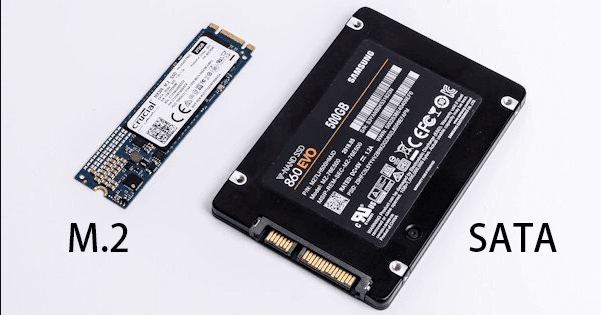You will learn the one-stop wizard for installing a second hard drive in Windows 10, whether it's external or internal, and migrating system or data afterward.
“I have a desktop computer running Windows 10 Home Edition, but it's running out of hard drive capacity. So I purchased a new 1TB solid-state drive to use as a second drive. Embarrassingly, I'm very hands-off and have very little knowledge of computers, so I don't know how to do it. Can anyone tell me how to install Windows 10 on a second hard drive? Any help would be appreciated!”

Like the user in the above case, many users want to install a second hard drive in Windows 10 because their computer run out space. Besides, you may want to do so in the following situations:
Whether you can install a second hard drive depends on the type of hard drive in your computer:
And then, you need to choose the right hard drive based on the following information:

After understanding how to pick the right hard drive, I will introduce you to the installation methods of external and internal hard drives. First of all, I will show you to how to install an external hard drive. In addition, I will focus on desktop computers since the methods for desktop computers and laptops are basically the same.
Installing an external hard drive is very easy, you just need to connect it through USB port and then store some photos or documents.
Step 1. Locate the USB port, connect external hard drive via its original USB cable, and then the USB port on the computer host. Please note that there are three types: USB-A, USB-B and USB-C.
Step 2. Open This PC, right-click on your external hard drive and then select Format... from the drop-down menu.
Step 3. A small window pop up. Select NTFS file system and uncheck the Perform a quick format, then click OK to start the formatting process.
Despite the portability benefits of external hard drives, you need to accept the following drawbacks when using them. If you cannot, please install a second internal hard drive as instead.
Compared to external hard drives, internal hard drives can compensate for the shortcomings I mentioned above except for being less portable. And the installation methods will vary depending on the types of internal hard drives (HDD or SSD). So I will introduce it to you separately.
For traditional hard drive, the best thing about HDD is that it is cheap and suitable for loading games, movies, and a lot of files. Please note that there will be a little different since every host has its own design.
For SSD disk (Solid State Disk or Solid State Drive), it has many advantages except relatively high price, such as fast read and write speeds, anti-shock, and anti-drop properties, low energy consumption. It also has no noise, large operating temperature range and lightweight compared to a traditional HDD. It is more suitable for installing systems to improve the speed of computers. And I'll introduce it in the next part.
Step 1. Using my case as an example and take it out, the hard drive bay is a pull-out design.
Step 2. Confirm the hard drive connector.
Step 3. Install the hard drive into the hard drive bracket and plug the SATA data cable and power interface into the HDD. There is no need to worry about plugging it in backwards since the interface usually has a dummy-proof design (also known as error proofing). And it cannot be plugged in if is reversed.
Step 4. Push the HDD with the bracket installed into the drive bay and make sure the clips are tight.
Step 5. Connect the drive to the motherboard using the other end of the SATA cable. Now the HDD is successfully installed
SD has different physical interfaces, the most common of which are the SATA and M.2 interfaces:
Since SATA interface SSDs are exactly the same as HDDs, which means their installation methods are also the same. So I will focus on M.2 interface SSDs in the following tutorials.
Step 1. Find M.2 slot location and fix the base screw.
Step 2. Take out the M.2 SSD. Using the gold finger as a reference, insert it completely into the M.2 slot, then lightly put down the whole M.2 SSD.
Step 3. Tighten the screws and fix the other end of the SSD. The second M.2 SSD is installed, then you just need to plug in and reboot your computer.
how to Install a second internal SSD in laptop:
The method for laptops and PCs is mostly the same. You just remove the bottom cover of the laptop, and find the M.2 slot and insert it. Finally, tighten the screws to complete the installation.
After your second hard drive has been physically installed, you will also have to initialize the disk, set the correct partition format and create partitions. Otherwise Windows 10 does not recognize this drive.
Recommended partition format:
Step 1. Open Disk management. Press Windows + R key and type diskmgmt.msc in the Run window, then press Enter.
Step 2. If it is a newly installed drive, the system will automatically pop up the initialization prompt. Then, select MBR or GPT depending on the size of your drive.
After initialization, you will go back to the Disk Management window. Then, continue to format and create a partition for your disk.
Step 1. Find the disk you install, right-click the black-marked unallocated space and select New Simple Volume.
Step 2. It will ask you for a specific size, file system, etc, just do as prompted.
Step 3. Wait until the process is complete, you will see a new partition. Right-click it and select Format in the drop-down menu. Remember to uncheck Perform a quick format to run a full format. And it will check the hard disk and fix some common errors by itself.
Once you have initialized and formatted hard drive, it means that you can use the drive normally. Then, you can perform system migration to improve computer performance if it is an SSD disk. Or you can transfer files from hard drive to another if it is a traditional hard drive. In this case, you may need the best migration software - AOMEI Backupper Professional.
To get started, please download AOMEI Backupper Professional at first.
(PS: The clone feature can only be demonstrated in the trial version, please upgrade pro trial version (10% discount) and then perform the cloning process.)
Step 1. Check the capacity of both disks and make sure that the target disk space is larger than or equal to the data size of the source disk. I mean the used space on both disk. Then, launch this software, click Clone and then System Clone in the right window.
Step 2. Select the target SSD for system migration and then click Next.
Step 3. Since you migrate OS from HDD to SSD, so it is suggested to check the SSD Alignment to improve reading and writting speed. Then preview the operation and click Start Clone to perform system migration.
Step 4. After the cloning is completed, you just need to reboot your computer. If your computer fails to boot correctly, change the startup sequence in the BIOS and reboot again.
Step 1. Launch AOMEI Backupper Professional again. Then, switch to Sync and Basic Sync.
You can also use other sync modes:
Step 2. Click Add Folders to select files on the old disk. Then, select the second hard drive in This PC.
Step 3. Confirm the source and destination directory, click Start Sync to transfer files from one hard drive to another. In daily use or for long-term data protection, try the following features:
👍 Daily, Weekly, and Monthly Sync: You can select one of them depending on your frequency. In daily sync, you can run the backup task every hour.
👍 Event Triggers: You can sync files at a specific event, including system shutdown, system startup, user logon, and user logoff.
👍 USB plug in: You can sync files to USB drive automatically without connecting it every time.
👍 Wake up computers and reconfigure operation after sync: Both features do a big favor when you want to sync files during off-peak hours, without human intervention.
You may encounter some problems during installing a second internal hard drive, and you might urgently need solutions. In the following, I will list the common problems and provide some solutions.
To check if the BIOS detects a newly installed hard drive, follow these steps.
Step 1. Power off the computer completely.
Step 2. Open the computer case and unplug the data cable from the hard drive and plug it in again.
Step 3. Turn on the computer and check that the hard drive is functioning properly.
Of course not. The hard drive is connected to the motherboard via the SATA or M.2 interface and does not affect other computer components. So even if you install multiple internal hard drives it will not affect the speed of your computer.
In fact, it is not a rare problem and many users face it. If you are also unlucky to encounter this problem and you are at your wits' end, you may try the following two methods to solve the problem.
Step 1. Click the Magnifying Glass in the bottom left corner of the Taskbar, and type Device Manager in the search box, and press Enter to open Device Manager.
Step 2. Click Disk drives in the list, and find the newly installed drive, then right-click it and select Update Driver Software in the drop-down menu.
Step 3. If there are any updates, please follow the instructions to update accordingly.
Step 1. Right-click the Start, select Disk Management and open this window. Find the newly installed drive in the list, and right-click on it then select Change Drive Letter and Paths.
Step 2. Click the Change in the window and select the appropriate drive next to the Assign the following drive letter.
Step 3. Click OK again to restart your computer.
Installing an external hard drive is relatively easy, but it's not as stable, has relatively low performance, and will take up a usb port. Thus, it's suggested to install a internal second hard drive in Windows 10 based on your needs.
For larger capacity, installing a hard drive, while for better performance, installing SSD. After installing, you need to make sure it's recognized and perform system or data migration with the best migration software - AOMEI Backupper. To perform migration on unlimited PC or servers, try AOMEI Backupper Techncian or TechPlus edition.